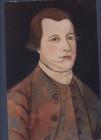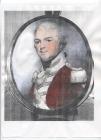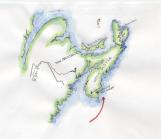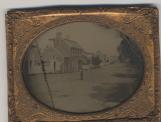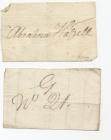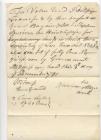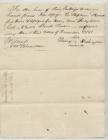1
Loyalist BeginningsThe Port Roseway Associates
Located on the south western shore of Nova Scotia, Port Roseway became a haven of refuge for over 12,000 Loyalist refugees of the American Revolution in 1783. Nearing the end of the American Revolutionary War, New York City was the last bastion of British fortification and thousands from the thirteen colonies along the Eastern seaboard of North America who supported Great Britain had congregated in that city for their safety and protection.
In late summer of 1782 those Loyalists who had been crowding into New York were aware of the terms of the treaty the British delegation to Paris would be required to accept in return for peace and they were aware that the Prime Minister of Great Britain, Lord Shelburne, had failed in his attempt to secure any guarantee of safety for those who had supported the British cause. Their lands would be confiscated and there would be no alternative but to leave the land they had known as "home". Many of those Loyalist families had roots going back to the first English settlements in North America. Some like Captain Gideon White were descendants of Mayflower passengers whose ancestors arrived in 1620.
It was decided among themselves to form associations in order to plan their departures to relocate in British territory. The Governor of Nova Scotia, Sir Andrew Snape Hammond made it known that those who wished to establish themselves in Nova Scotia would be most welcome, and they could continue to live there under British rule.
Port Roseway, a sheltered, deep harbour near nine miles in length and known then to be one of the world's finest natural harbours with its potential for the fishery, certainly met the requirements for building a new town based on commerce and trade.
The Loyalists associated with the purpose of removing and resettling themselves and their families to Port Roseway first met on November 16, 1782 and quickly appointed a committee of seven to transact their business with Sir Guy Carlton, Commander in Chief of the British Forces in North America and Sir Andrew Snape Hammond.
At the second meeting a week later Captain Joseph Durfee, who had been a successful merchant, mariner and ship owner in Newport, Rhode Island before the war was chosen as the president of the newly formed Port Roseway Associates, numbering over 300 men and including their families a total nearing 1500. The associates made plans to survey and lay out a township at the head of the harbour called Port Roseway, and also to survey the surrounding countryside in acreages from 50 to 500 acres; the majority of those lots measuring about 200 acres. The plan was approved by Governor John Parr, who had replaced Andrew Snape Hammond, and after the arrival of the Loyalists, they drew for the lots and the grants were made to them by King George III. In all about 400,000 acres of land reaching from the eastern boundaries of Barrington Township to the harbour of Port Mouton was parceled out.
The Loyalists were brought to Nova Scotia by British transport vessels, the first group arriving May 4, 1783. Successive fleets followed in June and early fall of 1783 and throughout the next few years. Within a year from the arrival of the first fleet, the population of the town swelled to approximately 10,000 including the Regimental units, Disbanded Soldiers and Free Blacks.
In July of 1783 Governor John Parr arrived on an inspection tour of the new town and bestowed upon it the new name of Shelburne in honour of William Petty Fitzmaurice, the 2nd Earl of Shelburne and then Prime Minister of Great Britain. Much land had been cleared, a grid street plan laid out and many new homes constructed.
The plans for the towns of Port Roseway and Birchtown had been drawn up in Halifax, Nova Scotia and sent to New York for approval by Sir Guy Carlton and returned to Nova Scotia. Port Roseway was a well designed settlement employing streets running 50 feet wide north and south and east-west dividing the town into 49 rectangular blocks-each block with 16 house lots. The town was angled against the waters edge on a sloping hill to the shore line. However, on the original plan no thought had been given consideration of wharves and warehouse lots- a certain necessity for the town's commercial success; alterations had to be made by the town's surveyors in order to accommodate its commercial and industrial intentions.
THE FREE BLACK LOYALISTS
Stephen Blucke, a Black Loyalist of fine character and education was commissioned by Governor Parr in 1784 as Lieutenant Colonel of the Black Militia and was placed in charge of six companies of Blacks-in all 499 Free Blacks who would receive grants of land in "Birchtown"-the town named for Brig. General Samuel Birch who had befriended the Black Loyalists in New York and authorized their certificates of freedom.
Upon arrival at Port Roseway, the Black Loyalists were allotted land to live on until their settlement "Birchtown" could be surveyed and lots drawn. The Birchtown site was situated on the northwest arm of Shelburne Harbour; Birchtown would measure a distance of approximately five miles from the town of Shelburne. Like his White counterpart, the first concern of the Black Loyalist was shelter before the winter months. The area was heavily forested and like the Shelburne town site was primarily granite stones and boulders. The first farm lots were not granted until 1787 and those were generally of 40 acres, however the soil was difficult to work and all their dreams of a "promised land" with sustaining gardens were quickly disminished. The Blacks were forced to look for employment within the Town of Shelburne or indenture themselves as servants once again to White Loyalists. The Black Loyalists who had occupational trades, offered their skills and services for a smaller wage than the disbanded soldiers; this brought much discontentment and conflicting situations which in turn brought more hardship and distress upon Black families.
Original land grant documents for the founding of Birchtown have not been discovered however, the most direct historic evidence has turned up in the form of land transfers of ownership which were purchased by Stephen Skinner, a merchant from Shelburne who had been appointed land agent by Governor Parr to purchase the granted lands to original Black settlers of Birchtown upon their emigration in 1792 to Sierra Leone, West Africa. These documents list names of original Black settlers with the original lot numbers in Birchtown. The fifteen land transfers are part of the Mrs Thomas Howland White Collection in the archives of the Shelburne County Museum, and represent a valuable documentation of part of Shelburne's 18th Century history.
It is not known how many of the lots eventually sustained comfortable homes, however, a letter from Birchtown written December 15, 1790 from Stephen Blucke to Stephen Skinner states: "herewith I return a list of your lots with the numbers and the blocks by which they are distinguished. John Waring's town lot is of 5 acres with a tolerable good log house thereon. It is near the country lot of Joseph Blais. I shall pay due attention to them."
The skills of the Black Loyalists were ample to have erected and built sturdy log structures for themselves and others within their own community. Indeed many were hired to help build fortifications, barracks and the infrastructure of the waterfront within the town of Shelburne. Pristine forests of white pine, hemlock,birch and red oak provided a veritable largesse of superior building product, nevertheless the outcroppings of granite seemed a formidable foe using the hand tools of the time.
When the opportunity arose in 1791 to return to Africa, many made the decision to return to the land of their roots.
John Wilberforce, a London abolishionist was aware of the distress of many Blacks in London, England and also those who had settled in parts of Nova Scotia. Plans were initiated to address this plight and with the help of the British Government re-settle the families who wished to go back to Africa. Under the direction of the Sierra Leone Company, Lieut. John Clarkson of the British Royal Navy was appointed to go to Nova Scotia to explain the terms of the Company to the Government there including such advantage or disadvantage the proposal might bring.
The number of people wishing to leave for Sierra Leone was overwhelming and Clarkson was afraid there may not be sufficient room aboard the transports to carry all those who had applied. On January 15, 1792 Clarkson set sail from Halifax, Nova Scotia with 544 Blacks from Shelburne and 646 from other areas of Nova Scotia where Blacks had settled after the Amercian Revolution- a total of 1190 on their way to found a new life in Freetown, Sierra Leone, West Africa. Eventually Freetown became the largest city on the West African Coast.
3
Joseph Durfee House1784
Churchover, Shelburne County, Nova Scotia, Canada
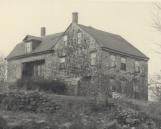 Credits:
Credits:Collection of The Shelburne County Museum
4
Pre Revolutionary America2003
Shelburne, Nova Scotia, Canada
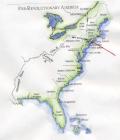 Credits:
Credits:Collection of The Shelburne County Museum
6
Grid pattern of original layout of streets in Town of Shelburne1785
Shelburne, Nova Scotia, Canada
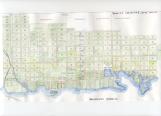
7
House built for Shelburne Loyalist, George Gracie in 1784.1950
Dock Street, Shelburne, Nova Scotia,Canada
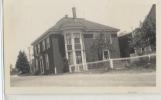
9
Peter Robinson, a Loyalist from New York came with his family of four to Shelburne in 1783.1783
Shelburne County Museum, Shelburne, Nova Scotia, Canada
